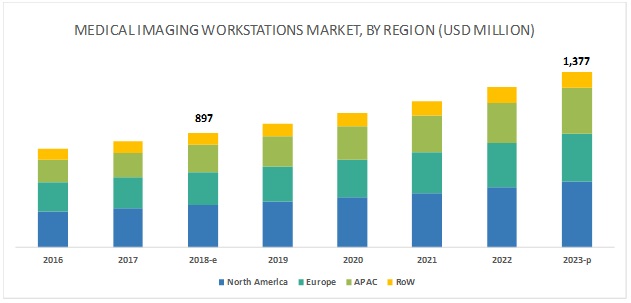The medical imaging workstations market is estimated to grow at a CAGR of 8.9% to reach USD 1,377 million by 2023 from USD 897 million in 2018. Factors such as the rising global burden of target diseases, increased product commercialization, rising public-private investments to support product development, evolving user preference for digital platforms, and the establishment of new medical facilities are driving the growth of the global market.
Diagnostic imaging workstations to dominate the market, by application, in 2018
On the basis of application, the market is segmented into diagnostic imaging, clinical review, and advanced imaging workstations. The diagnostic imaging workstations segment is expected to account for the largest share of the market in 2018 due to the ongoing market transition from 2D to 3D clinical diagnostics and the greater integration of healthcare infrastructure with PACS, cloud-based solutions, and thin-client platforms across mature countries.
North Americ a to account for the largest share of the medical imaging workstations market in 2018
a to account for the largest share of the medical imaging workstations market in 2018
This report covers the market across four major geographies, namely, North America, Europe, the Asia Pacific, and the Rest of the World (RoW). North America is expected to command the largest share of the market in 2018. This can be attributed to factors such as the high incidence/prevalence of various target diseases, presence of a large number of imaging centers, fast adoption of technologically advanced imaging systems, and the presence of prominent market players in this region.
General Electric Company (US), Koninklijke Philips N.V. (Netherlands), Siemens AG (Germany), Fujifilm Holdings Corporation (Japan), Canon Medical Systems Corporation (Japan), Carestream Health (US), Hologic (US), Carl Zeiss Meditec AG (Germany), Accuray Incorporated (US), Capsa Healthcare (US), Ampronix (US), Medicor Imaging (US), NGI Group (France), Alma IT Systems (Spain), and Pie Medical Imaging (Netherlands) are the major players operating in the market.
